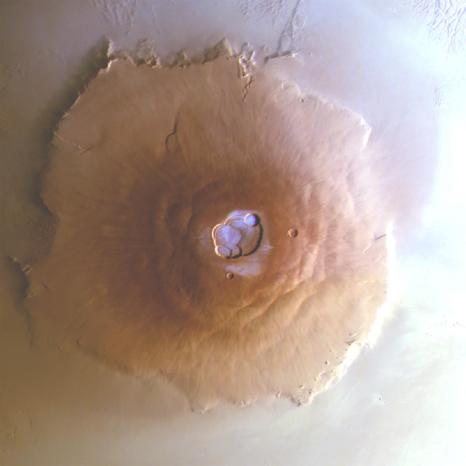Morning frost discovered for the first time on Mars’ volcanoes
A new international study involving a research team from the Geosciences Paris-Saclay Laboratory (GEOPS – Univ. Paris-Saclay/CNRS) has discovered water in the form of frost for the first time on the top of Mars’ volcanoes, near the equator. The discovery was published in Nature Geoscience on 10 June 2024.
The formation of water frost is common on Earth, particularly in winter, due to the condensation of water vapour. On Mars, however, the atmosphere contains 10,000 times less water vapour than on Earth, making the presence of frost less likely.
“We do not currently have a sufficient understanding of the exchange of water between the surface and atmosphere of the Red Planet”, said Frédéric Schmidt, a professor at Université Paris-Saclay and a researcher at the Geosciences Paris-Saclay Laboratory (GEOPS – Univ. Paris-Saclay/CNRS). “However, the formation of frost would be an important indicator in helping us to understand the water cycle but also in identifying key resources for potential future human exploration.”
In this new study, the scientists reported the existence of large deposits of transient morning frost at the top of volcanoes in a region of Mars called Tharsis, which includes the volcanoes Olympus, Arsia and Ascraeus Montes, and Ceraunius Tholus. The discovery was observed independently by the Colour and Stereo Surface Imaging System (CaSSIS) and the Nadir and Occultation for Mars Discovery (NOMAD) instruments onboard the European Space Agency’s (ESA) ExoMars Trace Gas Orbiter (TGO) spacecraft, as well as by the High Resolution Stereo Camera (HRSC) from ESA's Mars Express mission. Numerical simulations of Mars’ climate also show that the volcanoes’ surface temperatures are compatible with the existence of frozen water.
“The results show that morning frost deposits are correlated with the coldest Martian seasons”, added Frédéric Schmidt, who was involved in verifying the frost with CaSSIS, an instrument which currently possesses the best spectral resolution on Mars.
This discovery provides new insights into Martian climate dynamics, highlighting the importance of ongoing research to understand the water cycle on the Red Planet and to prepare for future Mars missions and possible human exploration.
Read the press release issued by the European Space Agency (ESA): https://www.esa.int/Science_Exploration/Space_Science/Mars_Express/Frosty_volcanoes_discovered_in_Mars_s_tropics/
Access the article published in Nature Geoscience: https://doi.org/10.1038/s41561-024-01457-7
Read the article in The Conversation: https://theconversation.com/water-frost-on-mars-on-the-top-of-immense-volcanoes-a-briefly-icy-landscape-23184
Contact for Université Paris-Saclay
Frédéric Schmidt, professor of planetary science, Geosciences Paris-Saclay Laboratory (GEOPS - Université Paris-Saclay/CNRS): frederic.schmidt@universite-paris-saclay.fr

